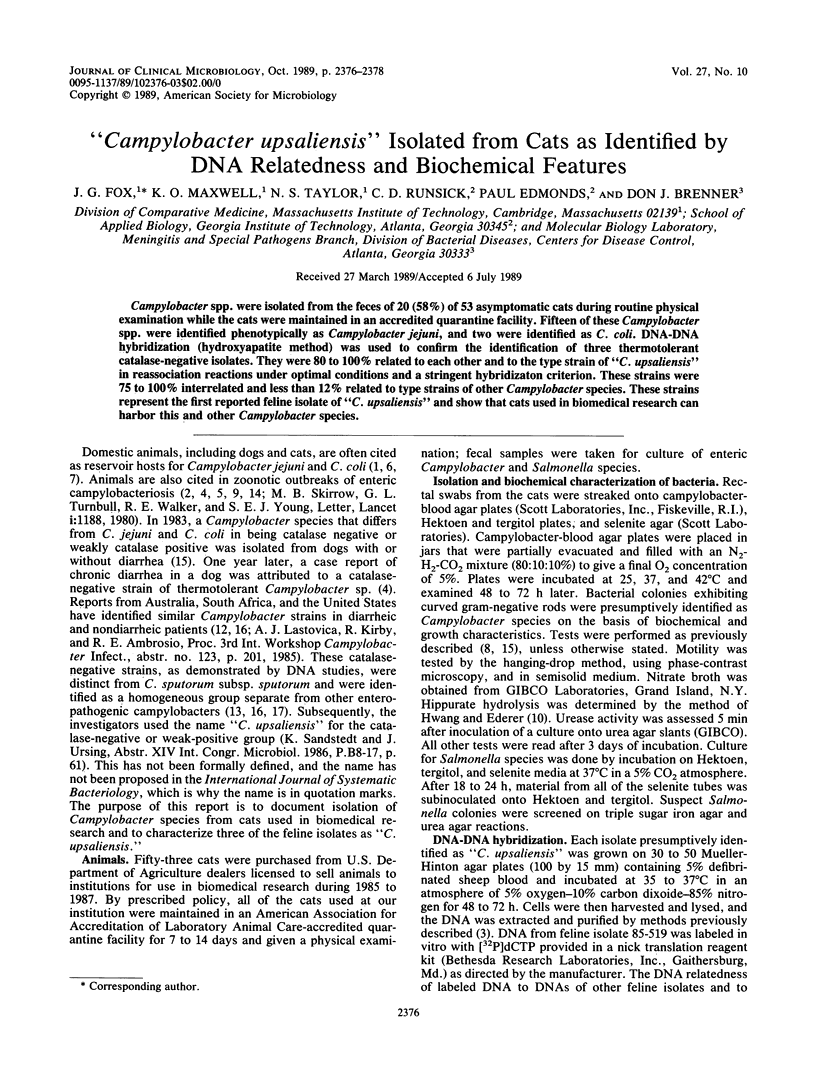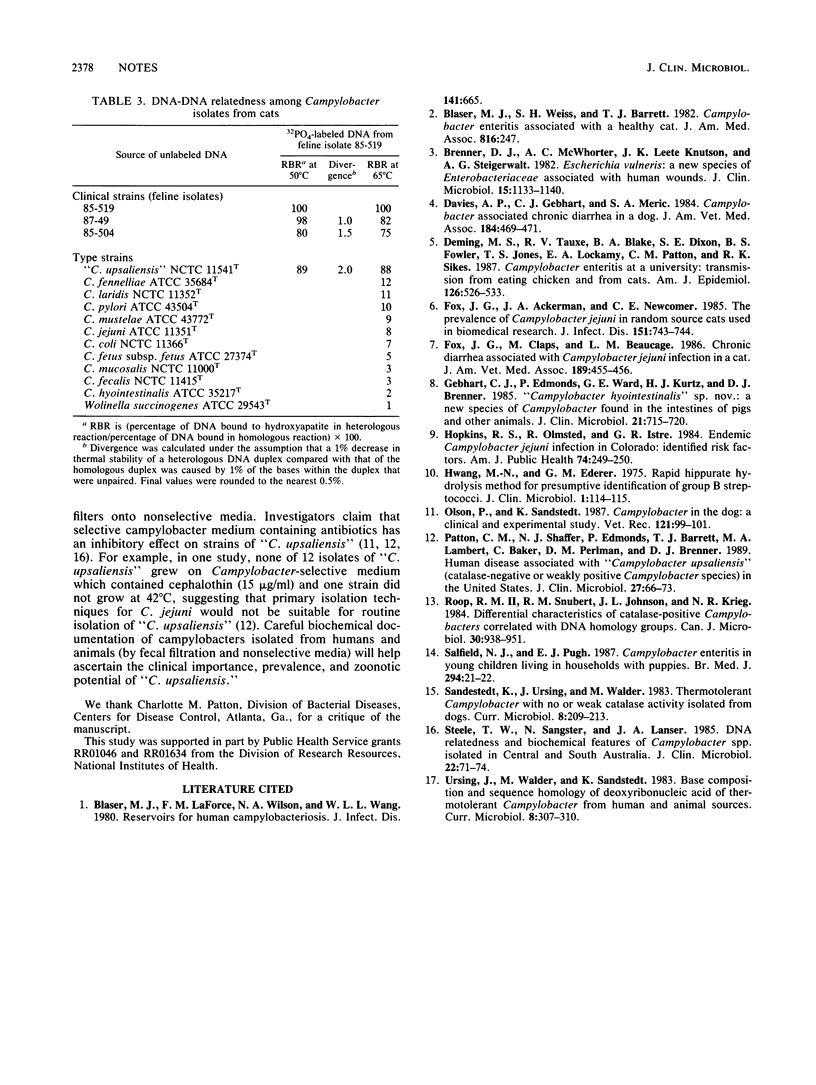Abstract
Campylobacter spp. were isolated from the feces of 20 (58%) of 53 asymptomatic cats during routine physical examination while the cats were maintained in an accredited quarantine facility. Fifteen of these Campylobacter spp. were identified phenotypically as Campylobacter jejuni, and two were identified as C. coli. DNA-DNA hybridization (hydroxyapatite method) was used to confirm the identification of three thermotolerant catalase-negative isolates. They were 80 to 100% related to each other and to the type strain of "C. upsaliensis" in reassociation reactions under optimal conditions and a stringent hybridization criterion. These strains were 75 to 100% interrelated and less than 12% related to type strains of other Campylobacter species. These strains represent the first reported feline isolate of "C. upsaliensis" and show that cats used in biomedical research can harbor this and other Campylobacter species.
Full text
PDF


Selected References
These references are in PubMed. This may not be the complete list of references from this article.
- Blaser M. J., LaForce F. M., Wilson N. A., Wang W. L. Reservoirs for human campylobacteriosis. J Infect Dis. 1980 May;141(5):665–669. doi: 10.1093/infdis/141.5.665. [DOI] [PubMed] [Google Scholar]
- Brenner D. J., McWhorter A. C., Knutson J. K., Steigerwalt A. G. Escherichia vulneris: a new species of Enterobacteriaceae associated with human wounds. J Clin Microbiol. 1982 Jun;15(6):1133–1140. doi: 10.1128/jcm.15.6.1133-1140.1982. [DOI] [PMC free article] [PubMed] [Google Scholar]
- Davies A. P., Gebhart C. J., Meric S. A. Campylobacter-associated chronic diarrhea in a dog. J Am Vet Med Assoc. 1984 Feb 15;184(4):469–471. [PubMed] [Google Scholar]
- Deming M. S., Tauxe R. V., Blake P. A., Dixon S. E., Fowler B. S., Jones T. S., Lockamy E. A., Patton C. M., Sikes R. O. Campylobacter enteritis at a university: transmission from eating chicken and from cats. Am J Epidemiol. 1987 Sep;126(3):526–534. doi: 10.1093/oxfordjournals.aje.a114685. [DOI] [PubMed] [Google Scholar]
- Fox J. G., Ackerman J. A., Newcomer C. E. The prevalence of Campylobacter jejuni in random-source cats used in biomedical research. J Infect Dis. 1985 Apr;151(4):743–744. doi: 10.1093/infdis/151.4.743. [DOI] [PubMed] [Google Scholar]
- Fox J. G., Claps M., Beaucage C. M. Chronic diarrhea associated with Campylobacter jejuni infection in a cat. J Am Vet Med Assoc. 1986 Aug 15;189(4):455–456. [PubMed] [Google Scholar]
- Gebhart C. J., Edmonds P., Ward G. E., Kurtz H. J., Brenner D. J. "Campylobacter hyointestinalis" sp. nov.: a new species of Campylobacter found in the intestines of pigs and other animals. J Clin Microbiol. 1985 May;21(5):715–720. doi: 10.1128/jcm.21.5.715-720.1985. [DOI] [PMC free article] [PubMed] [Google Scholar]
- Hopkins R. S., Olmsted R., Istre G. R. Endemic Campylobacter jejuni infection in Colorado: identified risk factors. Am J Public Health. 1984 Mar;74(3):249–250. doi: 10.2105/ajph.74.3.249. [DOI] [PMC free article] [PubMed] [Google Scholar]
- Hwang M. N., Ederer G. M. Rapid hippurate hydrolysis method for presumptive identification of group B streptococci. J Clin Microbiol. 1975 Jan;1(1):114–115. doi: 10.1128/jcm.1.1.114-115.1975. [DOI] [PMC free article] [PubMed] [Google Scholar]
- Olson P., Sandstedt K. Campylobacter in the dog: a clinical and experimental study. Vet Rec. 1987 Aug 1;121(5):99–101. doi: 10.1136/vr.121.5.99. [DOI] [PubMed] [Google Scholar]
- Patton C. M., Shaffer N., Edmonds P., Barrett T. J., Lambert M. A., Baker C., Perlman D. M., Brenner D. J. Human disease associated with "Campylobacter upsaliensis" (catalase-negative or weakly positive Campylobacter species) in the United States. J Clin Microbiol. 1989 Jan;27(1):66–73. doi: 10.1128/jcm.27.1.66-73.1989. [DOI] [PMC free article] [PubMed] [Google Scholar]
- Roop R. M., 2nd, Smibert R. M., Johnson J. L., Krieg N. R. Differential characteristics of catalase-positive campylobacters correlated with DNA homology groups. Can J Microbiol. 1984 Jul;30(7):938–951. doi: 10.1139/m84-147. [DOI] [PubMed] [Google Scholar]
- Salfield N. J., Pugh E. J. Campylobacter enteritis in young children living in households with puppies. Br Med J (Clin Res Ed) 1987 Jan 3;294(6563):21–22. doi: 10.1136/bmj.294.6563.21. [DOI] [PMC free article] [PubMed] [Google Scholar]
- Steele T. W., Sangster N., Lanser J. A. DNA relatedness and biochemical features of Campylobacter spp. isolated in central and South Australia. J Clin Microbiol. 1985 Jul;22(1):71–74. doi: 10.1128/jcm.22.1.71-74.1985. [DOI] [PMC free article] [PubMed] [Google Scholar]


